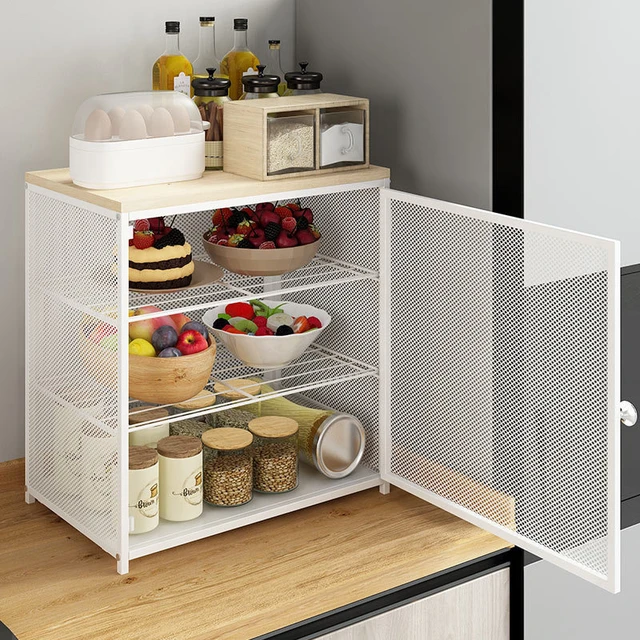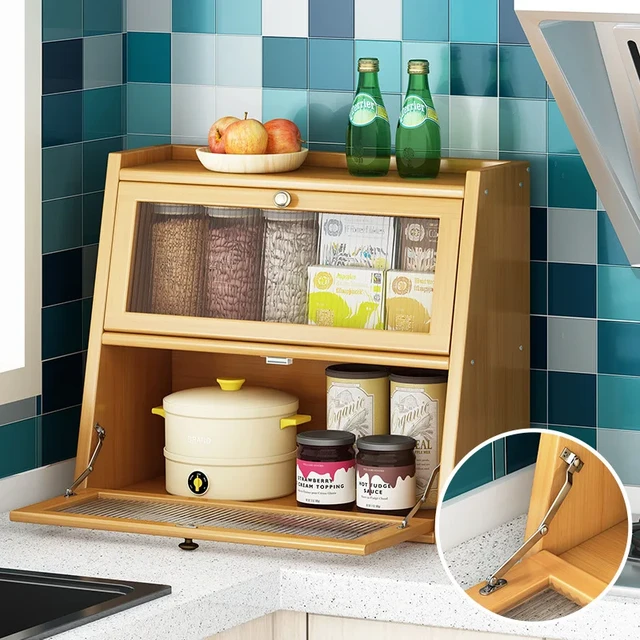 Introduction:
Introduction:
A storage cabinet is an essential component of any kitchen, providing a designated space for organizing and storing various items. From cookware and utensils to pantry staples and small appliances, a well-designed storage cabinet ensures a clutter-free and efficient kitchen. In this comprehensive guide, we will explore the features, benefits, and considerations of storage cabinets for kitchens. By understanding different cabinet styles, organization tips, and space-saving solutions, individuals can create a functional and visually appealing kitchen environment.
 Cabinet Styles and Configuration
Cabinet Styles and Configuration
Base Cabinets:
Base cabinets are the standard cabinets installed on the floor, offering storage for large items like pots, pans, and baking sheets.
They typically feature shelves or drawers and can be customized with various door styles and finishes.
Wall Cabinets:
Wall cabinets are installed on the walls, providing storage for frequently used items such as spices, glasses, and cookbooks.
They are often accompanied by glass doors or open shelving options to display decorative or frequently accessed items.
Tall Cabinets or Pantry Cabinets:
Tall cabinets or pantry cabinets are full-height cabinets that maximize storage space for dry goods, canned foods, and small appliances.
They often feature adjustable shelves and pull-out drawers for easy access to stored items.
Organization Tips for Storage Cabinets
Categorizing and Grouping Items:
Organize items based on categories, such as cookware, bakeware, utensils, or food items.
Group similar items together to maximize efficiency and make items easily accessible.
Utilizing Organizational Tools and Inserts:
Incorporate organizational tools, such as drawer dividers, shelf risers, and spice racks, to maximize space utilization and create a well-structured cabinet.
Use drawer inserts or dividers to separate and organize utensils, flatware, and smaller kitchen items.
Labeling and Clear Containers:
Label bins, containers, or shelves to enhance organization and ensure items are easily identifiable.
Utilize clear storage containers to store pantry items, creating visibility and preventing unnecessary clutter.
Space-Saving Solutions
Pull-out Shelving and Drawers:
Include pull-out shelves or drawers within cabinets to optimize access to items stored at the back.
This feature reduces the need to reach and rummage through cabinets, making it easier to retrieve items.
Corner Cabinets and Lazy Susans:
Make use of corner cabinets by installing a lazy Susan or pull-out shelving unit to maximize corner space.
These mechanisms provide easy access and efficient use of corner cabinets, which are notoriously challenging to organize.
Vertical Storage and Hanging Solutions:
Utilize vertical space by incorporating hooks, railings, or magnetic strips on the inside of cabinet doors to hang utensils, pot lids, or small tools.
This strategy keeps frequently used items within reach while freeing up drawer or shelf space.
 Considerations for Choosing Storage Cabinets
Considerations for Choosing Storage Cabinets
Cabinet Materials and Finishes:
Consider durability, maintenance, and style when selecting cabinet materials and finishes.
Common options include wood, laminate, or thermofoil finishes, each with its own characteristics and aesthetic appeal.
Space and Layout:
Assess the available space in the kitchen and consider the layout when choosing the size and configuration of storage cabinets.
Customization options allow for tailored solutions that maximize space and meet individual needs.
Quality and Durability:
Invest in quality storage cabinets that can withstand the demands of a busy kitchen.
Ensure that the cabinets are built with sturdy construction and high-quality hardware to ensure long-lasting use.
Here are some common positions for kitchen storage cabinets:
In a kitchen, storage cabinets are typically placed in strategic locations to maximize convenience and functionality. Here are some common positions for kitchen storage cabinets:
Upper Cabinets:
Upper cabinets are commonly placed above countertops and are often used to store dishes, glassware, and other frequently used items. They are typically mounted at a reachable height, allowing easy access to frequently used items.
Lower Cabinets:
Lower cabinets are positioned beneath countertops and are ideal for storing larger kitchen appliances, cookware, and food items. They provide ample storage space and can be equipped with shelves, drawers, or pull-out racks to optimize organization and accessibility.
Pantry Cabinets:
Pantry cabinets are designed specifically for storing pantry items such as dry goods, canned goods, and spices. These cabinets are usually freestanding or built-in and can be positioned in a separate area or integrated into the kitchen layout.
Corner Cabinets:
Corner cabinets are utilized to maximize storage space in kitchens, particularly in corners. They often feature rotating or pull-out shelves, allowing easy access to items stored in the corner area that might otherwise be hard to reach.
Island Cabinets:
Kitchen islands often incorporate storage cabinets beneath the countertop surface. These cabinets provide additional storage space for kitchen tools, utensils, and larger items that are frequently used during food preparation.
Wall-mounted Cabinets:
Wall-mounted cabinets can be installed above countertops or other work areas, utilizing vertical space in the kitchen. These cabinets are suitable for storing lighter items or items that are used less frequently.
The specific placement of storage cabinets in a kitchen depends on the available space, layout, and individual preferences. The goal is to achieve an efficient and organized kitchen by strategically positioning cabinets in areas that are easily accessible and cater to the specific storage needs of the household.
 When it comes to cleaning and maintaining storage cabinets for the kitchen
When it comes to cleaning and maintaining storage cabinets for the kitchen
When it comes to cleaning and maintaining storage cabinets for the kitchen, here are some important considerations:
Regular Cleaning:
It is important to clean the cabinets regularly to remove any dust, dirt, or grease buildup. Use a mild detergent or a solution of warm water and vinegar to wipe down the surface of the cabinets. Avoid using harsh or abrasive cleaners that can damage the finish.
Avoid Excess Moisture:
Cabinets should be kept dry to prevent damage. Wipe up any spills or water immediately to avoid moisture seeping into the wood or causing discoloration. Be cautious with liquid cleaners and avoid excessive use of water when cleaning the cabinet surfaces.
Protect Cabinet Finishes:
Using a protective finish or sealant on the cabinet surfaces can help prevent stains and make cleaning easier. Follow the manufacturer’s instructions for appropriate sealants or finishes for the specific cabinet material.
Handle Cleaning:
Pay attention to the cabinet handles or knobs, as these are areas that can accumulate dirt and grease from frequent use. Clean them regularly with a mild cleaner and a soft cloth to keep them looking and functioning well.
Shelf Organization:
Consider using shelf liners or mats to protect the cabinets from spills or sticky residues. These liners can be easily removed and cleaned as needed.
Avoid Heavy Loads:
Avoid overloading the cabinets with excessive weight, as this can strain the hinges and cause damage over time. Be mindful of the weight capacity of the shelves and distribute the load evenly.
Regular Inspection:
Regularly inspect the cabinets for any signs of damage, such as loose hinges or cracks. Repair or replace any damaged parts promptly to prevent further issues.
Proper Ventilation:
Ensure that the kitchen has proper ventilation to minimize moisture and humidity levels, which can affect the condition of the cabinets.
By following these cleaning and maintenance practices, you can keep your kitchen storage cabinets in good condition and prolong their lifespan. Regular cleaning, proper handling, and preventive measures will help maintain the appearance and functionality of the cabinets over time.
 Conclusion:
Conclusion:
Storage cabinets are a vital component of a well-organized and functional kitchen. By understanding different cabinet styles, organization strategies, and space-saving solutions, individuals can optimize their kitchen storage and create a clutter-free environment. With the comprehensive information provided in this guide, individuals can confidently select storage cabinets that suit their needs, maximize space utilization, and enhance the overall aesthetic of their kitchen. A well-designed storage cabinet system ensures a seamless cooking experience, making it easier to locate and access utensils, cookware, and pantry items. Embrace the possibilities of a well-organized kitchen with the help of storage cabinets, creating a space that combines efficiency and style.
